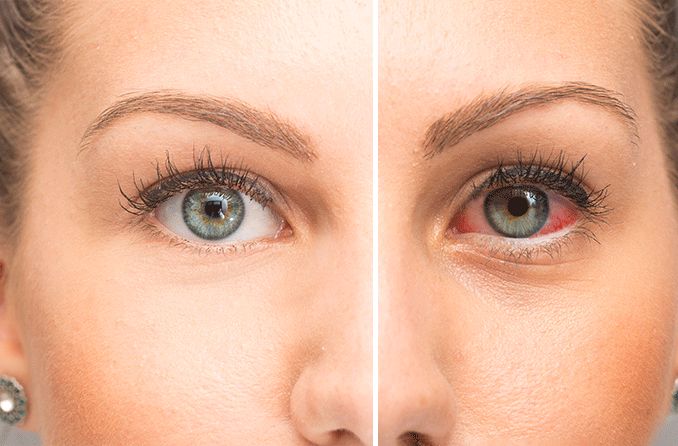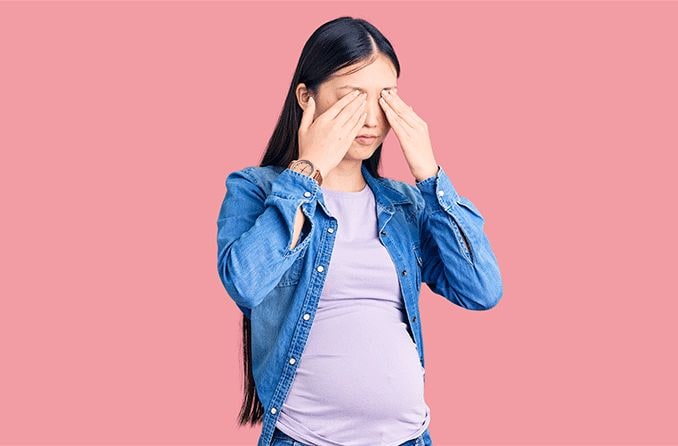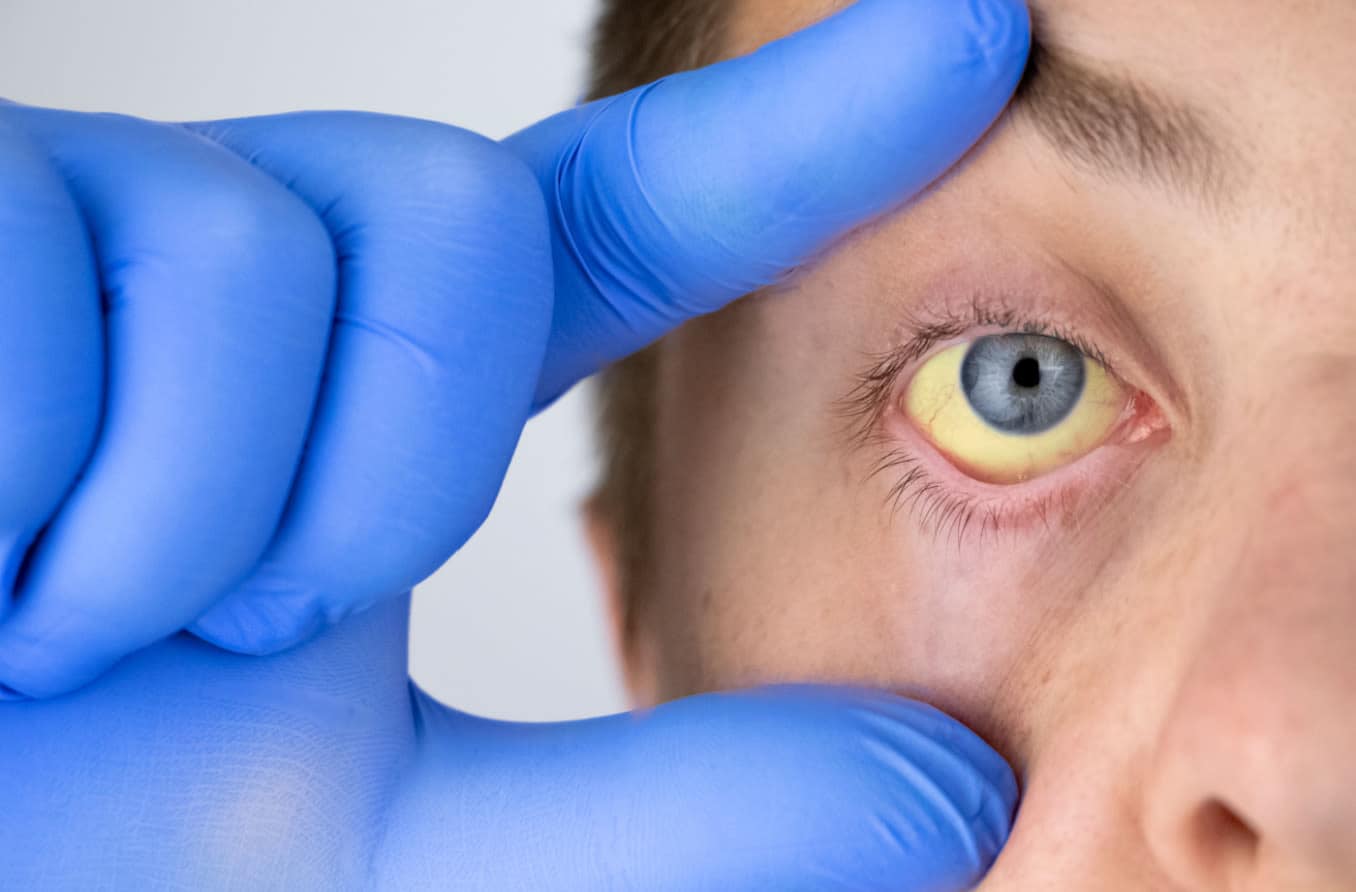Beyoncé said it best with her famous lyric, “Who run the world? Girls.”
Women are strong, incredible creatures that have mastered the art of keeping things together, even when they’re at a disadvantage. Unfortunately, a serious disadvantage women face is with their eye health.
Research done in the past 20 years has shed light on how females are at a significantly higher risk of vision changes, damage and loss than men. In fact, females are 12% more likely to experience vision loss than males.
Though serious vision conditions are not unique to women, they can experience different and greater effects on their vision than men. So, what can women do?
There are many biological factors contributing to vision problems that women can’t control. However, knowing the risks makes it possible to take steps toward vision protection, increasing the number of women living with healthy eyes and healthy vision.
Hormone changes and vision
Hormones are chemicals that send messages to different parts of the body and affect many important functions. These include mood, sexual function, growth and development, and the ability to reproduce.
The hormones that differentiate males and females are sex hormones, or sex steroids. Major sex hormones in a female endocrine system, the network that hormones function within, are:
- Estrogen – This plays an important role in reproductive and sexual development, beginning in puberty.
- Progesterone – This helps regulate menstrual cycles and prepares the body for pregnancy.
- Androgens – These make up a group of sex hormones that affect fertility, bone mass, sex drive and red blood cell production. Women only have small amounts, while men have larger amounts (testosterone is the most common androgen).
Because hormones are so powerful, a chemical imbalance can cause serious changes within the body, including the eyes. Research has shown that tissues in the eyes have sex hormone receptors. This means eye and vision problems can occur in response to changes in sex hormone levels.
Some of the biggest hormone changes that many women experience are during puberty, pregnancy and menopause.
SEE RELATED: What causes blurry vision during pregnancy?
How vision changes during puberty
Adolescent females typically enter puberty between ages 8 and 13. When a girl begins puberty, her body makes more follicle-stimulating hormones and luteinizing hormones. This triggers the production of estrogen and progesterone.
Not long after, girls usually experience their first menstruation cycle. During this cycle, and every cycle that follows, estrogen and progesterone levels change. These hormone changes can have an effect on their vision.
A study published in the Chinese Medical Journal on hormone changes and vision monitored the cycles of 120 myopic adolescent females, aged 15 to 16. Ocular measurements, as well as estradiol (a form of estrogen) levels were recorded for each girl’s eyes.
The eyes and hormone levels were remeasured on four different occasions throughout each girl’s cycle. Results showed a small difference in eye measurements — such as eyeglass prescription — each time they were taken, depending on where the girl was in her cycle. Measurements seemed to change with the estradiol levels in the eye.
Vision changes during pregnancy
When a woman becomes pregnant, hormone levels change significantly. Besides the estrogen and progesterone, a new set of pregnancy hormones are added to the mix. Pregnancy hormones include human chorionic gonadotropin (hCG) and human placental lactogen (hPL).
Because these hormones are produced by the placenta, they are only present during pregnancy.
The presence of these hormones can cause subtle, temporary changes in and around the eyes during pregnancy. They often resolve once the baby is delivered, or after the mother stops breastfeeding. These changes can affect their:
- Eyelids – Many pregnant women have increased pigmentation around the eyelids called melasma or chloasma. Experts believe hormone changes increase melanin production during pregnancy that can result in darkening of the skin in certain areas.
- Corneas – The corneas may change in thickness, curvature and sensitivity during pregnancy. This can result in a refractive error, which causes blurry vision. It’s also possible for women who wore contact lenses before pregnancy to develop a temporary intolerance to them.
- Tear production – Pregnancy requires the work of many hormones. Sometimes these hormones can affect the tear film and lacrimal glands of the eyes, leading to dry eye syndrome.
- Intraocular pressure (IOP) – Pressure within the eye decreases during pregnancy, though it’s rare for pressure to become dangerously low while pregnant. However, having low IOP can cause corneal swelling and irregularities, resulting in decreased vision.
- Lenses – Accommodation is a function of the eye’s lens that allows it to change focus from distant vision to near vision. During pregnancy and lactation, some women have reported losing their accommodation ability.
Women who are diabetic before becoming pregnant are at an increased risk of diabetic retinopathy. The risk of diabetic retinopathy is low in women who develop diabetes during pregnancy — a condition called gestational diabetes.
READ MORE: Vision changes during pregnancy
Vision changes during menopause
Menopause occurs when a woman no longer has menstrual periods and can no longer conceive. After menopause, the ovaries that produce sex hormones will only make small but consistent amounts of the hormones.
One of the major vision-related changes experienced is dry eye syndrome after menopause.
Estrogens and androgens play a major role in the eye’s lubrication system. As mentioned earlier, different tissues in the eyes have sex hormone receptors. One of the places where these receptors are located is the meibomian glands.
The tear film that keeps the eyes hydrated is made up of three layers: The aqueous layer, the lipid layer and the mucin layer. Meibomian glands, located on the eyelids, produce the lipid layer. This layer keeps the eyes moist by preventing the aqueous layer from evaporating.
Research is conflicting on whether estrogen or androgen replacement is best for dry eyes in post-menopausal women.
Some studies suggest that the meibomian glands are an androgen target organ. This means the receptors respond best to the androgen hormone. So, it’s believed that androgen can help the glands produce the lipid layer and relieve dry eye symptoms.
Furthermore, studies on post-menopausal women with low estrogen found that their risk of dry eye syndrome actually increased when they started estrogen replacement therapy. They also had more severe symptoms.
A sure-fire treatment for post-menopausal dry eye is still unknown. But some studies suggest androgen replacement therapy is a viable treatment.
In addition to dry eye syndrome, some research indicates that menopause may increase a few risk factors that could contribute to glaucoma development. However, research has also linked estrogen replacement therapy with a small reduction of intraocular pressure.
Vision and age
According to research done by the Centers for Disease Control and Prevention, females live an average of 5.4 years longer than males. While this may not seem like very long, five extra years of life can make women more susceptible to age-related eye disease.
Eye conditions that are common in older age include:
Cataracts
Cataracts are a result of clouding of the eye’s lens. They’re caused by the clumping of lens proteins that occurs during the aging process. Cataracts usually grow slowly over time, and can cause dull, hazy and blurry vision.
In severe cases, untreated cataracts can lead to vision loss. Cataract surgery can remove cataracts and restore clear vision. Though cataracts are common among older people, data shows that females are at a higher risk of developing them than males.
Glaucoma
Women outnumber men in glaucoma cases worldwide. The condition is characterized by high pressure in the eye that can lead to optic nerve damage. The increased pressure is due to an imbalance between the production of an inner eye fluid, called aqueous humor, and its ability to flow out.
Eye pressure that stays too high for too long can damage the optic nerve at the back of the eye, which can cause vision loss. Glaucoma treatment may include eye drops, oral medications or surgery.
Age-related macular degeneration
Age-related macular degeneration (AMD) is a condition that involves the loss of light-sensitive cells (photoreceptors) in the macula. The macula is the central area of the retina, and is responsible for your sharpest central vision and color vision.
In late stages of AMD, a person may have little or none of their central vision, but will likely still have their peripheral vision. There is no cure for AMD, and current treatment is only effective for a certain type called wet AMD.
Statistics from 2010 showed that women made up 65% of AMD cases, while men only made up 35%.
Retinal detachment
Retinal detachment occurs when the light-sensitive tissue at the back of the eye (the retina) separates from the eyeball. This separation cuts off blood supply to the retina, which can cause cells responsible for your vision to die.
Emergency surgery is the only way to repair a detached retina. The sooner the retina can be reattached, the more likely that vision can be restored.
Though retinal detachment isn’t more likely to happen to women, research suggests that women are not receiving the same level of care for this condition as men. Insured women are 34% less likely to have surgery to repair retinal detachment than insured men.
SEE RELATED: How vision changes as you age
Autoimmune disease and vision
Females are twice as likely to develop an autoimmune disease than males. Though the exact reason is still being researched, it’s believed that the disparity has to do with female genetics and hormones.
Genetics and risk of autoimmune disease
Chromosomes are passed down from parents to their offspring and determine certain traits. Females are born with two X chromosomes (XX), while males are born with one X chromosome and one Y chromosome (XY).
The X chromosome is larger than the Y chromosome and has a greater number of immune-related genes. These genes help trigger immunological responses within the body. Having a greater number of genes also means there’s a higher chance of having a gene mutation. The combination of these factors increases the risk of women having an autoimmune response.
To put it simply, X chromosomes are at higher risk for an autoimmune mutation than Y chromosomes. Because females have two X chromosomes, they’re getting a “double dose” of autoimmune risk.
Hormones and autoimmune risk
Estrogen is a pro-inflammatory hormone, and androgen, like testosterone, is an anti-inflammatory hormone. It’s possible that because women have much higher levels of pro-inflammatory estrogen than men, they are more prone to autoimmune problems. However, this theory is still being investigated.
Autoimmune disorders and vision
There are many different types of autoimmune disorders. The ones seen most commonly in women are:
- Rheumatoid arthritis (RA) causes damage to healthy connective tissue found in the eyes, and other areas throughout the body. Eye problems associated with RA include dry eye syndrome, uveitis, scleritis, cataracts and more.
- Lupus symptoms include rashes around the eyelids and retinal vasculitis. Lupus may also cause dry eyes, scleritis and optic nerve damage.
- Graves' disease affects the thyroid gland and causes an overproduction of thyroid hormone. Graves’ disease affects the eyes through inflammation, eye bulging, eye misalignment and more. Patients may also develop thyroid eye disease, which has its own set of symptoms and complications.
- Multiple sclerosis (MS) damages healthy tissue in the brain and spinal cord. The most common vision-related symptom of MS is inflammation of the optic nerve (optic neuritis).
SEE RELATED: Sjogren's syndrome: What is it?
Diabetes and vision
There’s not much a woman can do about her hormones, genetics or the changes that come with growing older. But practicing healthy habits can help protect the eyes from conditions like diabetes.
Males are twice as likely to develop type 2 diabetes as females. However, complications of diabetes, like heart disease, are more likely to affect women.
On its own, diabetes can have serious consequences for vision, like diabetic retinopathy. Diabetic retinopathy results from damage to the retina’s blood vessels from consistently high blood sugar. These damaged blood vessels within the retina begin to leak, which can result in vision-threatening complications.
Diabetic retinopathy can also lead to swelling in the macula, known as macular edema. Both macular edema and diabetic retinopathy can result in blindness if symptoms aren't managed.
Heart disease and diabetes typically go hand in hand. Major risk factors for heart disease, like hypertension and high cholesterol, can cause blockages or bleeding in the eyes and threaten vision.
Besides having an effect on the eyes, heart disease is the leading cause of death for women in the United States. This makes it especially important to maintain a healthy lifestyle and have regular physicals and eye exams.
How women can protect their vision
Women are known to be natural caregivers. This often means they put others’ needs before their own. While this is one of many wonderful qualities women have, it’s important for them to be proactive about their health and well-being too.
Here are some steps you can take to protect your vision:
Prioritize your eye health
Women aged 18 to 60 should have a comprehensive eye exam at least once every two years. If you’re considered an at-risk patient due to family history or your own vision history, an eye exam should be performed every year. Scheduling and having an eye exam can give you some peace of mind knowing that your vision and eye health is at its best.
It’s also important for women to recognize any vision changes and report them to an eye doctor, even if the change isn’t necessarily bothering them. Vision changes could be something minor, or they could be sight threatening. Keeping your eye doctor informed of changes in your vision can put them, and you, on the right track for potential treatment.
Know your family’s medical history
Genetics and family history play a big role in vision. From minor refractive errors, to glaucoma and AMD, vision conditions can be passed down genetically.
Being aware of your family history, and letting your doctor know about conditions that run in your family, can help them be on the lookout for certain conditions.
Avoid or stop smoking
Smoking adds nothing positive to your health, including the health of your eyes. Smokers are at a greater risk of cataracts, AMD, inflammatory conditions and more.
If you smoke, make an effort to quit. Non-smokers should continue to avoid smoking.
Wear sunglasses outside
Sunglasses aren’t just for summer days at the pool. Wearing sunglasses whenever you’re outdoors, or when driving, can protect your eyes from harmful UV rays. Make sure you’re wearing quality sunglasses that block 99% to 100% of UVA and UVB rays.
Eat a balanced diet
Working fruits, vegetables and antioxidants into your diet can help delay or prevent the onset of certain eye conditions. It’s also good to:
- Eat whole grains and healthy fats
- Get your protein from lean meats, fish, nuts and eggs
- Drink plenty of water
You can also take certain vitamins to supplement your diet: Vitamin A (and beta-carotene), vitamin C, vitamin E and zinc are all good choices for keeping your eyes healthy.
Incorporate moderate exercise into your routine
It’s recommended that 150 minutes (2.5 hours) of moderate activity be done each week to maintain good physical health. This can be broken up into little bits of activity throughout the week to make the goal seem more manageable.
Examples of moderate activity include brisk walking, dancing, bike riding, water aerobics, hiking, roller skating and pushing a lawn mower. Regular physical activity can help reduce your risk of developing vision and other health conditions, and keep you feeling good as you get older.
READ MORE: Women's Eye Health & Safety Month







